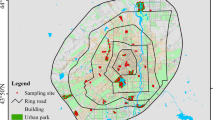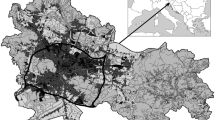Abstract
Urbanization is developing rapidly in the world, which seriously changes the habitat of organisms and has clearly a negative effect on biodiversity. Preservation of biodiversity is crucial in urban planning and management, which is also an important symbol for the level of greening. Problems such as scarcity of urban green space and plant species have become obstacles to the establishment of ecological friendly cities. However, coexistence of nature and modernization, as well the coordination of economic development and biodiversity, are goals that people are seeking. We have taken the built-up areas of Beijing as a study case and discussed the impacts of urbanization on plant diversity, with the support of fieldwork and SPOT remote sensing data. The results are as follows: 1) in the process of urbanization, exotic plants have been widely introduced, which has affected species composition and the proportion of native plants; it is clear that artificial green spaces always will have a lower level of plant diversity than natural green spaces; 2) functional differences of green space types partially decide their species abundance, so that plant diversity in greenbelts and streets is generally lower than in parks; 3) the spatial variety of plant diversity contributes much to the imbalance of district development and the planning of different functional zones; this variation is embodied in different ring-belts and directions; 4) habitat fragmentation also affects plant diversity to a great extent; there is a significant positive correlation between high fragmentation and low plant diversity. According our results, some suggestions are proposed, which would be suitable for the preservation of plant diversity and ecological improvement during urbanization.
Similar content being viewed by others
References
Behera M D, Kushwaha S P S, Roy P S. 2005. Rapid assessment of biological richness in a part of Eastern Himalaya: an integrated three-tier approach. For Ecol Manage, 207: 363–384
Chen L D, Fu B J. 1996. Analysis of impact of people activity on landscape structure in Yellow River delta. Acta Ecol Sin, 16(4): 337–344 (in Chinese with English abstract)
Collinge S K. 1998. Spatial arrangement of habitat patches and corridors: clues from ecological weld experiments. Landscape Urban Plan, 42: 157–168
Collins J P, Kinzig A, Grimm N B, Fagan W F, Hope D, Wu J, Borer E T. 2000. A new urban ecology. Am Sci, 88: 416–425
Czech B, Krausman P R, Devers P K. 2000. Economic associations among causes of species endangerment in the United States. Biol Sci, 50: 593–601
Jeffrey D K, Alissa M, Ralph J A. 2001. Integrating urbanization into landscape level ecological assessments. Ecosystem, 4: 3–18
Lee P F, Ding T S, Hsu F H, Geng S. 2004. Breeding bird species richness in Taiwan: Distribution on gradients of elevation, primary productivity and urbanization. J Biogeogr, 31: 307–314
Liu J F, Xiao W F, Jiang Z P, Feng X, Li X Y. 2005. A study on the influence of landscape fragmentation on biodiversity. For Res, 18(2): 222–226 (in Chinese with English abstract)
Margaret M B. 2006. Urban landscape conservation and the role of ecological greenways at local and metropolitan scales. Landscape Urban Plan, 76: 23–44
Meng X S, Ouyang Z Y, Cui G F, Li W F, Zheng H. 2004. Composition of plant species and their distribution patterns in Beijing urban ecosystem. Acta Ecol Sin, 24(10): 2200–2206 (in Chinese with English abstract)
Miller J R, Cale P. 2000. Behavioral mechanisms and habitat use by birds in a fragmented agricultural landscape. Ecol Appl, 10(6): 1732–1748
Smith R M, Thompson K, Hodgson J G, Warren P H, Gaston K J. 2006. Urban domestic gardens (IX): Composition and richness of the vascular plant flora, and implications for native biodiversity. Biol Conserv, 129: 312–322
Stefan K. 2006. Urbanization and homogenization-comparing the floras of urban and rural areas in Germany Ingolf Kuhn. Biol Conserv, 127: 292–300
Turner K, Lefler L, Freedman B. 2005. Plant communities of selected urbanized areas of Halifax, Nova Scotia, Canada. Landscape Urban Plan, 71: 191–206
Wang X P. 1996. The effects of urbanization on biodiversity. Rural Eco-Environ, 12(4): 32–36 (in Chinese with English abstract)
Whitford V, Ennos A R, Handley J F. 2001. “City form and natural process”-indicators for the ecological performance of urban areas and their application to Merseyside. UK Landscape Urban Plan, 57: 91–103
Yu K J. 1998. Challenges and opportunities that Chinese gardens faced with, analysis from the three stages of gardens development in the world. Chin Landscape Architect, 14(1): 18–21 (in Chinese with English abstract)
Zhang F, Wu Y Z, Zhang G P, Ru W M. 2006. Analysis on some mistakes in the application of statistics in ecological researches. J Plant Ecol, 30(2): 361–364
Zhang W J, Qi Y H, Schoenly K G. 2002. Randomization tests and computational software on statistic significance of community biodiversity and evenness. Biodiver Sci, 10(4): 431–437 (in Chinese with English abstract)
Zhao H W. 2005. Development of city’s gardens green-making in Beijing. J Beijing Agric Coll, 20(2): 43–45 (in Chinese with English abstract)
Zhao S Q, Fang J Y, Lei G C. 2001. Theoretical basis for species conservation: from the theory of island biogeography to metapopulation dynamic theory. Acta Ecol Sin, 7: 1171–1179 (in Chinese with English abstract)
Author information
Authors and Affiliations
Corresponding author
Rights and permissions
About this article
Cite this article
Liang, Yq., Li, Jw., Li, J. et al. Impact of urbanization on plant diversity: A case study in built-up areas of Beijing. For. Stud. China 10, 179–188 (2008). https://doi.org/10.1007/s11632-008-0036-4
Received:
Accepted:
Published:
Issue Date:
DOI: https://doi.org/10.1007/s11632-008-0036-4




